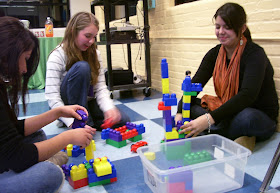 We're excited to welcome a new exhibit celebrating children's books to the Museum's atrium walkway, just in time for National Reading Month!
We're excited to welcome a new exhibit celebrating children's books to the Museum's atrium walkway, just in time for National Reading Month!See a traveling display of Illustrator Quilts – created by Brooklyn-based author, educator and literacy consultant Muriel Feldshuh – that incorporate original art from more than 90 famous illustrators from around the country, including Eric Carle, Tomie dePaola and Marc Brown.
 Also discover Illustration Inspiration, a "ramp box" exhibit created by 17 Museum staff and AmeriCorps members. Our ramp box exhibits follow a theme and change several times a year. It's a unique challenge, to create something visually engaging in such a small space. This time each person created a scene inspired by one of their favorite children’s book artists, like Maurice Sendak, Chris Van Allsburg and Beatrix Potter.
Also discover Illustration Inspiration, a "ramp box" exhibit created by 17 Museum staff and AmeriCorps members. Our ramp box exhibits follow a theme and change several times a year. It's a unique challenge, to create something visually engaging in such a small space. This time each person created a scene inspired by one of their favorite children’s book artists, like Maurice Sendak, Chris Van Allsburg and Beatrix Potter. We are all so impressed with the result – it's an amazing collaboration, the work of 17 (!) individuals using a variety of materials, each with their own style and story to tell. The boxes are vibrant, detailed and just plain interesting to look at. Here are photos of a few of the boxes created by AmeriCorps members, with the artists' stories about their process and inspiration:
We are all so impressed with the result – it's an amazing collaboration, the work of 17 (!) individuals using a variety of materials, each with their own style and story to tell. The boxes are vibrant, detailed and just plain interesting to look at. Here are photos of a few of the boxes created by AmeriCorps members, with the artists' stories about their process and inspiration:
 "I chose Maurice Sendak because I have always enjoyed the glorious creepiness of his drawings, and the wonderful quality of movement he can imply. The idea: playing in the city. "
"I chose Maurice Sendak because I have always enjoyed the glorious creepiness of his drawings, and the wonderful quality of movement he can imply. The idea: playing in the city. "-Miranda Elliott Rader
 "Tomie DePaola's illustrations are realistic, yet there is a softness created by their textures and colors that appeal to my tactile senses - I want to touch the spaghetti and ruffle Big Anthony's hair in Strega Nona...I feel the humor of DePaola's illustrations appeals to a range of ages - it is accessible to children, yet sophisticated."
"Tomie DePaola's illustrations are realistic, yet there is a softness created by their textures and colors that appeal to my tactile senses - I want to touch the spaghetti and ruffle Big Anthony's hair in Strega Nona...I feel the humor of DePaola's illustrations appeals to a range of ages - it is accessible to children, yet sophisticated."-Kate Jones
 "I chose [Trina Schart Hyman] because I was fascinated by her work as a kid - she's someone who draws for a lot of different authors, and it was a long time before I learned who she was. The elements I emphasize in my ramp box are strong female characters, a wide age range, the outdoors, people reading and a sense of adventure."
"I chose [Trina Schart Hyman] because I was fascinated by her work as a kid - she's someone who draws for a lot of different authors, and it was a long time before I learned who she was. The elements I emphasize in my ramp box are strong female characters, a wide age range, the outdoors, people reading and a sense of adventure."-Melissa Kline
 "David A. Carter creates pop-up books that jump and spring to life...my ramp box includes bright colors and imagery featuring several miniature visuals from exhibits within the Museum - a miniature crazy wavy mirror wall, the Iway spanning the box, and fountains bubbling up, down and sideways."
"David A. Carter creates pop-up books that jump and spring to life...my ramp box includes bright colors and imagery featuring several miniature visuals from exhibits within the Museum - a miniature crazy wavy mirror wall, the Iway spanning the box, and fountains bubbling up, down and sideways."-Jennifer McIntosh
Coming soon: more inspiration stories, from our staff artists.
Come take a look! The quilts and ramp box exhibit will be on display through May. And in March & April, join our celebration of art and stories with a series of special programs, including Seussational! this Sunday from 1:00 - 4:00 PM!












